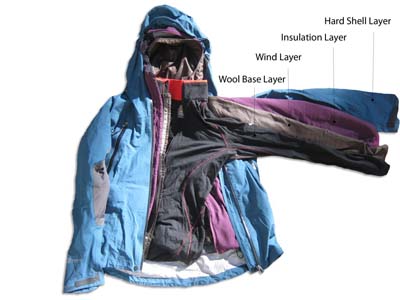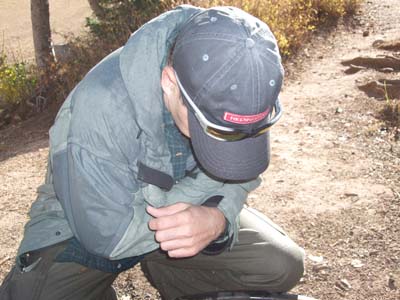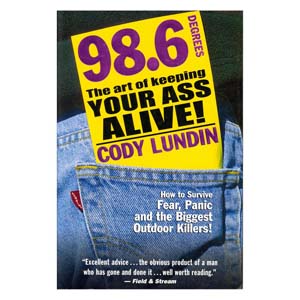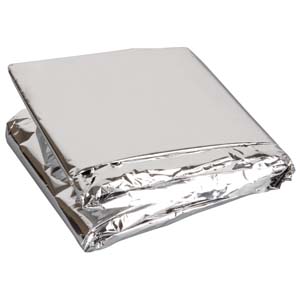Preventing And Treating Hypothermia
By Dan Kidder
Managing Editor
On average, between 800 and 1,500 people die each year in the United States from hypothermia, a condition of the core temperature of the body reaching a dangerously low level. The temperature drop necessary to become dangerous is not a vast change from our normal 98.6 degrees. As little as a few degrees can become dangerous and 10 degrees is most likely going to be fatal. This drop in core temperature can occur even in mild temperatures and it is common for people to die from hypothermia on a day in the mid-50's to low 60's.
As a survival instructor, I spend a great deal of time on proper thermoregulation of body temperature in our classes. Following the rule of threes, we can spend days and weeks without water or food, respectively, but the cold can kill us in hours. The number-one killer in an outdoor emergency is exposure. This is a generalization of conditions such as instability of thermoregulation, frostbite, chilblains, and cascading effects of these conditions such as dehydration. Exposure is a very simplified label and doesn’t often address the underlying conditions. It makes an easy label on a coroner’s report but oversimplifies the real conditions that lead to death; conditions that can be prevented and treated in the field.
An Ounce Of Prevention…
As Benjamin Franklin noted, time and energy spent preventing a problem is far more efficient than treating the problem once it occurs. The simplest way to cure hypothermia, is prevent the condition from occurring. Hypothermia is a condition, not a disease, so minimizing the factors that contribute to it is the best way to prevent it. Essentially, hypothermia is a change in the body’s basal metabolic rate caused by the way the body adapts to changes in the surrounding temperature and how the body adjusts to prevent death and attempts to regulate internal temperature. As warm-blooded creatures, humans generate heat through our metabolism, converting nutrients into heat. If our exposure to cold outpaces the calories we consume, then the body begins to adjust to try to conserve the heat we lose. Medical conditions, exertion, lack of food and water, and use of medications, drugs, or alcohol can increase susceptibility to increased exposure to cold and make people more likely to suffer from hypothermia.
As the body is exposed to cold, its natural defense is to draw blood into the core of the body, sacrificing limbs and digits to protect vital organs. It also begins to shiver to generate heat through kinetic energy. As a response, the body sees this increase in blood pressure in the core as an increase in fluid and you begin to excrete fluids through sweating and urination. This can lead to dehydration.
 So how do we prevent hypothermia? First, limit exposure to cold. Layering clothing that better prevents heat loss by trapping air between layers is one way to prevent overcooling of the body. This works in the inverse by keeping out the colder air from outside. Gloves protect the fingers, and good wool socks protect the feet. A hat is a must to prevent heat loss from the head and a good scarf protects against cold exposure at the neck, where a lot of blood comes near the surface. This is great when our body is trying to protect us from hyperthermia (getting too hot) but is deadly when we are getting too cold.
So how do we prevent hypothermia? First, limit exposure to cold. Layering clothing that better prevents heat loss by trapping air between layers is one way to prevent overcooling of the body. This works in the inverse by keeping out the colder air from outside. Gloves protect the fingers, and good wool socks protect the feet. A hat is a must to prevent heat loss from the head and a good scarf protects against cold exposure at the neck, where a lot of blood comes near the surface. This is great when our body is trying to protect us from hyperthermia (getting too hot) but is deadly when we are getting too cold.
Second, stay dry. Our body uses evaporative cooling to keep us from getting overheated. Getting wet makes our body cool down at a rate as much as 25 times faster than when we are dry. If we get wet from rain or snow, falling into a body of water, or from sweating, we are at a much greater risk of hypothermia than if we stay dry. Again, a key element here is proper layering of clothing. Rain gear that breathes well to allow the escape of perspiration but keeps out moisture from rain or snow is essential when traveling into the backcountry. Good base layers that retain warmth, such as Merino wool, are excellent protectors of our core temperature. Wool also retains warmth when wet because of air pockets trapped within the fibers. Cotton kills. Cotton has finer fibers that lack the air pockets of wool or some synthetic fibers and also acts as a sponge to hold water. Hydrophobic fibers like wool and some synthetics repel water and prevent the fibers from holding onto the water, where it will slowly evaporate and create a cooling effect. Also, by layering our clothing, we can remove items as we exert ourselves. Gathering firewood, building shelter, seeking calories, making water drinkable, all increase the likelihood that we will perspire. Working slowly and methodically will limit overexertion and perspiration as well.
 Third, find ready-made shelter or build shelter to limit wind exposure. Wind carries cold, and also increases evaporative cooling. Creating a break between ourselves and the wind will limit that exposure. A ready-made windbreak like a fallen tree, a stone outcropping, a cave, or a big friendly rock (BFR) can dissipate the wind enough to provide some relief.
Third, find ready-made shelter or build shelter to limit wind exposure. Wind carries cold, and also increases evaporative cooling. Creating a break between ourselves and the wind will limit that exposure. A ready-made windbreak like a fallen tree, a stone outcropping, a cave, or a big friendly rock (BFR) can dissipate the wind enough to provide some relief.
Fourth, stay hydrated and fed. As the body pulls in blood to its core, it registers an increase in hydration and urges you to excrete what it sees as excess fluids. Additionally, it consumes nutrients to convert them into calories (a unit of heat measurement). By staying hydrated and also consuming calories, your body avoids dehydration and also has more fuel to provide more warmth.
Fifth, limit conduction. One of the ways we lose heat is through conduction. This is touching something cold that directly transfers heat from our body into the cold object. Since cold isn’t a real thing, but an absence of heat, things we perceive as cold will transfer heat into the vacuum caused by a lack of heat energy. This conduction draws heat from our body into the ground or cold rock much faster than we would lose it normally. Creating a bed of leaves, tree limbs, blankets, or something else that has multiple air pockets between ourselves and the conductor, i.e., the ground, will limit the amount of body heat we lose.
Sixth, fire photon torpedoes. Generate heat. Light is heat energy. The photons of light carry heat energy and a good fire or other radiant heat source will carry short wave radiation toward us and warm our bodies. We can also gather stored long-wave radiation from rocks that have been warmed all day in the direct rays of the sun. Either way, something that can generate additional heat, whether it be a Zippo pocket hand warmer, air activated hand warmers, a fire, a backpacking stove, electric socks, or even a campfire all provide additional heat energy. You can even reflect that heat energy by using a Mylar emergency blanket either on the far side of your fire to reflect it back towards you or behind you to bounce the radiation that misses you back toward yourself. They also make a great ground insulator to minimize conduction, or as a wind break, or as an impromptu shelter to divert rain. Just don’t use them as a blanket. More on that later.
So, a recap on prevention in bullet point form, because people like bullet points.
- Limit exposure by layering clothing
- Stay dry
- Find or create shelter to minimize wind
- Stay hydrated and fed
- Get off the ground and limit conduction
- Generate heat
 …Or A Pound Of Cure
…Or A Pound Of Cure
Treating a patient who has hypothermia is pretty straightforward, but will depend on how severe the condition is, your level of medical training, and the resources that are available to you. It will also depend a great deal on whether you are able to limit their exposure to cold air. The key element to remember in treating hypothermia is to go slow. Too rapid a change in their core temperature can induce shock or heart arrhythmia, which can kill the patient.
Before trying any treatment, it is key to diagnose their condition as actual hypothermia and note the extent of the condition. The symptoms are:
- Shivering
- Confusion, memory loss, or slurred speech
- Drop in core body temperature below 95 °F
- Exhaustion or drowsiness
- Numb hands or feet
- Shallow breathing
- Loss of consciousness
The best time to begin treating hypothermia is when the very first symptoms start to present. This incipient stage is marked by uncontrollable shivering, a slight tinging of blue around the lips and mouth, and sleepiness or lethargy. If possible, get the patient into a warmer surrounding or take the steps outlined above to prevent the condition from getting worse.
If the patient starts to slip in and out of consciousness, it is time to get them to an emergency room immediately. This is the severe stage of hypothermia and if it progresses, it will be fatal. The emergency staff will need to remove blood from the body and warm it before putting it back in a process like dialysis with a heater. They also need to stand by with a shock and cardiac care team in case the patient goes into arrhythmia.
If medical help is not available, you need to slowly begin to warm the patient. Do not plunge them into warm or hot water. Surround them with warm, dry blankets. If they are conscious, give room temperature fluids to them to keep them hydrated and provide warmth internally. Never try to give fluids or food by mouth to an unconscious person. If they are unconscious and dehydrated, they will need an IV of saline and that should only be administered by someone qualified to do so.
They will likely be dehydrated and hypoglycemic (low blood sugar), in addition to hypothermic. This is called the wilderness triad, and the three conditions often go together in those rescued from exposure, as the body’s basal metabolic system uses resources to fight cooling down. If they are conscious, something light, such as room temperature soup or electrolyte drink containing sugar may be helpful.
Once the patient is stabilized, start to make plans to get them evacuated to a medical facility as soon as possible. This isn’t a matter of a little cold killing someone. It is a serious issue of the body going into shock or the patient having a heart attack and it is very possible for what you think isn’t serious to result in death.
 The best cure for hypothermia is to prevent it from happening in the first place, or to take steps early on to prevent it from progressing. If that is not possible, take steps to stabilize the patient, going very slowly to help raise their body temperature. Evacuate them as soon as possible and get them to an emergency medical facility at the first opportunity so medical professionals can be standing by in case of a serious and life-threatening secondary condition like shock or heart attack. Hypothermia kills a good number of experienced outdoors people every year, so treat it as a serious concern so you don’t become the next victim. A great resource on the subject that is easy to read and provides much more information than I can in an article is Cody Lundin’s book 98.6 Degrees - The Art of Keeping Your Ass Alive.
The best cure for hypothermia is to prevent it from happening in the first place, or to take steps early on to prevent it from progressing. If that is not possible, take steps to stabilize the patient, going very slowly to help raise their body temperature. Evacuate them as soon as possible and get them to an emergency medical facility at the first opportunity so medical professionals can be standing by in case of a serious and life-threatening secondary condition like shock or heart attack. Hypothermia kills a good number of experienced outdoors people every year, so treat it as a serious concern so you don’t become the next victim. A great resource on the subject that is easy to read and provides much more information than I can in an article is Cody Lundin’s book 98.6 Degrees - The Art of Keeping Your Ass Alive.
 The Mylar Emergency Blanket
The Mylar Emergency Blanket
“Nothing in the outdoor products world will kill you faster if it is used as it is marketed,” said Doug Ritter, founder of the Equipped to Survive Foundation about the ubiquitous emergency blanket. These compact sheets of silver mylar are sold everywhere as an essential piece of kit to prevent hypothermia. The downside is that they should never be used as a survival blanket as they hold in moisture expelled through perspiration and respiration, causing you to become damp and lose heat much faster.
- That doesn’t mean that they are completely useless. They have several uses in an emergency, but never as a blanket to wrap yourself in. Here are some great uses for an emergency blanket:
- Windbreak – hang with paracord or a stick frame to block blowing wind.
- Reflector – Hang on the far side of your fire or behind you to reflect more infrared radiation.
- Thermal Ground Break – Place over leaves or boughs to insulate you from heat loss and sit or lie on top.
- Rain Fly – Hang perpendicular to the ground or form a tent to shield from failing rain.
- Some tips to keep in mind: Mylar tears very easily. Tie cordage to the corners rather than poking a hole that will spread and shred your blanket. Wrapping a stone in the corner will help prevent cord from slipping off.
- The reflector is easy to see from the air. Use your blanket as a rescue flag or streamer.
- The waterproof nature of the material makes it a great aid for gathering and transporting water. It can be used to capture falling rainwater or snow or be used in a solar still.
- In the case of a penetrating chest wound, the blanket can be used with duct tape to create an improvised chest seal.
- The blanket can be cut into pieces and used to wrap boots to keep them dry in the snow.
- While the emergency blanket is terrible as a blanket, it is still an inexpensive and versatile tool to carry in your kit.

